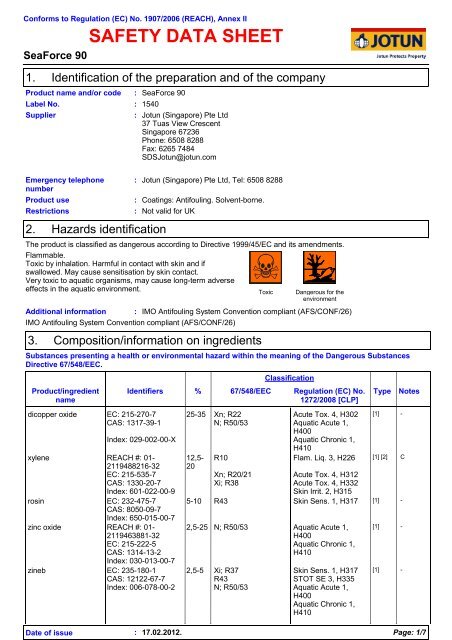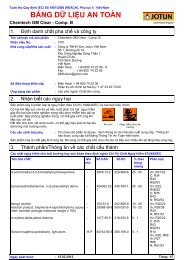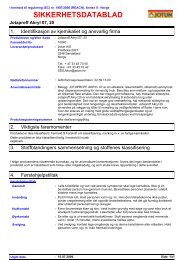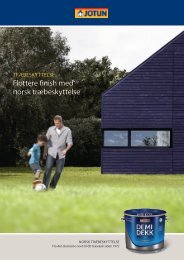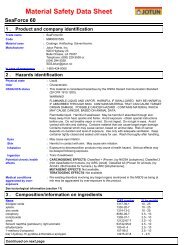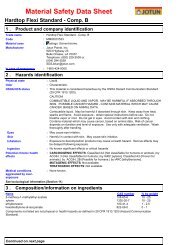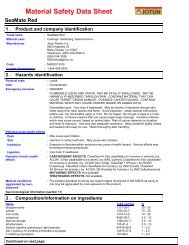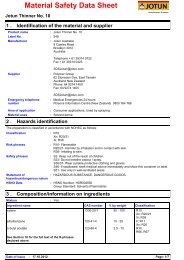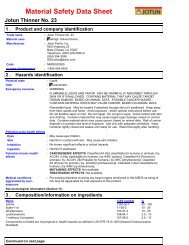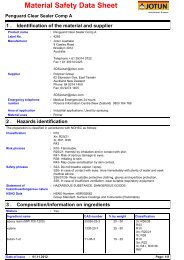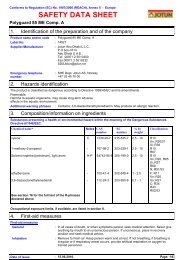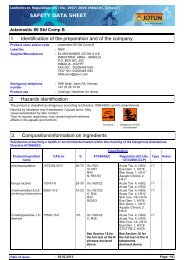SeaForce 90 - Marine_Protective - English (uk) - Jotun
SeaForce 90 - Marine_Protective - English (uk) - Jotun
SeaForce 90 - Marine_Protective - English (uk) - Jotun
- No tags were found...
You also want an ePaper? Increase the reach of your titles
YUMPU automatically turns print PDFs into web optimized ePapers that Google loves.
Conforms to Regulation (EC) No. 1<strong>90</strong>7/2006 (REACH), Annex IISAFETY DATA SHEET<strong>SeaForce</strong> <strong>90</strong>1.SupplierIdentification of the preparation and of the companyProduct name and/or code :Label No. : 1540:<strong>SeaForce</strong> <strong>90</strong><strong>Jotun</strong> (Singapore) Pte Ltd37 Tuas View CrescentSingapore 67236Phone: 6508 8288Fax: 6265 7484SDS<strong>Jotun</strong>@jotun.comEmergency telephonenumberProduct useRestrictions2.::<strong>Jotun</strong> (Singapore) Pte Ltd, Tel: 6508 8288Coatings: Antifouling. Solvent-borne.: Not valid for UKHazards identificationThe product is classified as dangerous according to Directive 1999/45/EC and its amendments.Flammable.Toxic by inhalation. Harmful in contact with skin and ifswallowed. May cause sensitisation by skin contact.Very toxic to aquatic organisms, may cause long-term adverseeffects in the aquatic environment.Toxic Dangerous for theenvironmentAdditional informationIMO Antifouling System Convention compliant (AFS/CONF/26)3.: IMO Antifouling System Convention compliant (AFS/CONF/26)Composition/information on ingredientsSubstances presenting a health or environmental hazard within the meaning of the Dangerous SubstancesDirective 67/548/EEC.Product/ingredientnameIdentifiersdicopper oxide EC: 215-270-7CAS: 1317-39-1Index: 029-002-00-Xxylene REACH #: 01-2119488216-32EC: 215-535-7CAS: 1330-20-7Index: 601-022-00-9rosin EC: 232-475-7CAS: 8050-09-7Index: 650-015-00-7zinc oxide REACH #: 01-2119463881-32EC: 215-222-5CAS: 1314-13-2Index: 030-013-00-7zineb EC: 235-180-1CAS: 12122-67-7Index: 006-078-00-2% 67/548/EEC Regulation (EC) No. Type1272/2008 [CLP]25-35 Xn; R22N; R50/5312,5-20R10Xn; R20/21Xi; R38Acute Tox. 4, H302Aquatic Acute 1,H400Aquatic Chronic 1,H410Flam. Liq. 3, H226Acute Tox. 4, H312Acute Tox. 4, H332Skin Irrit. 2, H315[1] -[1] [2] C5-10 R43 Skin Sens. 1, H317 [1] -2,5-25 N; R50/53 Aquatic Acute 1,H400Aquatic Chronic 1,H4102,5-5 Xi; R37R43N; R50/53ClassificationSkin Sens. 1, H317STOT SE 3, H335Aquatic Acute 1,H400Aquatic Chronic 1,H410[1] -[1] -NotesDate of issue : 17.02.2012.Page: 1/7
<strong>SeaForce</strong> <strong>90</strong>ethylbenzene EC: 202-849-4CAS: 100-41-4Index: 601-023-00-41-methoxy-2-propanol REACH #: 01-2119457435-35EC: 203-539-1CAS: 107-98-2Index: 603-064-00-3Solvent naphtha(petroleum), lightarom.bis(1-hydroxy-1hpyridine-2-thionatoo,s)copperREACH #: 01-2119455851-35EC: 265-199-0CAS: 64742-95-6Index: 649-356-00-4EC: 238-984-0CAS: 14915-37-83-7 F; R11Xn; R20
<strong>SeaForce</strong> <strong>90</strong>6. Accidental release measuresPersonal precautionsSpill::Exclude sources of ignition and ventilate the area. Avoid breathing vapour or mist.Refer to protective measures listed in sections 7 and 8.Contain and collect spillage with non-combustible, absorbent material e.g. sand,earth, vermiculite or diatomaceous earth and place in container for disposalaccording to local regulations (see section 13). Preferably clean with a detergent.Avoid using solvents.Note: see section 8 for personal protective equipment and section 13 for waste disposal.7.HandlingHandling and storage:Prevent the creation of flammable or explosive concentrations of vapours in air andavoid vapour concentrations higher than the occupational exposure limits.In addition, the product should only be used in areas from which all naked lights andother sources of ignition have been excluded. Electrical equipment should beprotected to the appropriate standard.To dissipate static electricity during transfer, earth drum and connect to receivingcontainer with bonding strap. Operators should wear antistatic footwear and clothingand floors should be of the conducting type.Keep away from heat, sparks and flame. No sparking tools should be used.Avoid contact with skin and eyes. Avoid the inhalation of dust, particulates, spray ormist arising from the application of this preparation. Avoid inhalation of dust fromsanding.Eating, drinking and smoking should be prohibited in areas where this material ishandled, stored and processed.Put on appropriate personal protective equipment (see Section 8).Never use pressure to empty. Container is not a pressure vessel.Always keep in containers made from the same material as the original one.Comply with the health and safety at work laws.Information on fire and explosion protectionVapours are heavier than air and may spread along floors. Vapours may formexplosive mixtures with air.When operators, whether spraying or not, have to work inside the spray booth,ventilation is unlikely to be sufficient to control particulates and solvent vapour in allcases. In such circumstances they should wear a compressed air-fed respiratorduring the spraying process and until such time as the particulates and solventvapour concentration has fallen below the exposure limits.Storage:Store in accordance with local regulations.Notes on joint storageKeep away from: oxidising agents, strong alkalis, strong acids.Additional information on storage conditionsObserve label precautions. Store in a dry, cool and well-ventilated area. Keep awayfrom heat and direct sunlight. Keep away from sources of ignition. No smoking.Prevent unauthorised access. Containers that have been opened must be carefullyresealed and kept upright to prevent leakage.8. Exposure controls/personal protectionEngineering measuresIngredient namexyleneethylbenzene:Provide adequate ventilation. Where reasonably practicable, this should be achievedby the use of local exhaust ventilation and good general extraction. If these are notsufficient to maintain concentrations of particulates and solvent vapours below theOEL, suitable respiratory protection must be worn.Occupational exposure limitsEU OEL (Europe, 12/2009). Absorbed through skin. Notes: listof indicative occupational exposure limit valuesSTEL: 442 mg/m³ 15 minute(s).STEL: 100 ppm 15 minute(s).TWA: 221 mg/m³ 8 hour(s).TWA: 50 ppm 8 hour(s).EU OEL (Europe, 4/2006). Absorbed through skin. Notes:IndicativeLimit value: 100 ppm 8 hour(s).Limit value: 442 mg/m³ 8 hour(s).Short term limit value: 200 ppm 15 minute(s).Short term limit value: 884 mg/m³ 15 minute(s).Date of issue : 17.02.2012.Page: 3/7
<strong>SeaForce</strong> <strong>90</strong>1-methoxy-2-propanolSolvent naphtha (petroleum), lightarom.bis(1-hydroxy-1h-pyridine-2-thionatoo,s)copperEU OEL (Europe, 12/2009). Absorbed through skin. Notes: listof indicative occupational exposure limit valuesSTEL: 568 MG/M3 15 minute(s).STEL: 150 PPM 15 minute(s).TWA: 375 MG/M3 8 hour(s).TWA: 100 PPM 8 hour(s).EU OEL (Europe, 6/2000).TWA: 100 mg/m³ 8 hour(s). Form: All formsTWA: 20 ppm 8 hour(s). Form: All formsArch Chemicals (Europe, 2002).TWA: 0,35 mg/m³ 8 hour(s).Personal protective equipmentRespiratory system :If workers are exposed to concentrations above the exposure limit, they must useappropriate, certified respirators. Use respiratory mask with charcoal and dust filterwhen spraying this product.(as filter combination A2-P3). In confined spaces, usecompressed-air or fresh-air respiratory equipment. When use of roller or brush,consider use of charcoalfilter.Skin and bodyHands::Personnel should wear antistatic clothing made of natural fibres or of hightemperature-resistantsynthetic fibres.For prolonged or repeated handling, use the following type of gloves: gloves:polyvinyl alcohol or nitrile.Eyes9.Physical stateOdourColourFlash pointSolubility:Physical and chemical propertiesBarrier creams may help to protect the exposed areas of the skin but should not beapplied once exposure has occurred.For right choice of glove materials, with focus on chemical resistance and time ofpenetration, seek advice by the supplier of chemical resistant gloves.The user must check that the final choice of type of glove selected for handling thisproduct is the most appropriate and takes into account the particular conditions ofuse, as included in the user's risk assessment.Use safety eyewear designed to protect against splash of liquids.Liquid.Characteristic.Various colours.Density : 1.7 g/cm 3Explosion limits : 1.1 - 13.1%10.Stability and reactivity:::::Closed cup: 28°C (82,4°F)Insoluble in the following materials: cold water and hot water.Stable under recommended storage and handling conditions (see section 7).Hazardous decomposition products: carbon monoxide, carbon dioxide, smoke, oxides of nitrogen.Keep away from the following materials to prevent strong exothermic reactions: oxidising agents, strong alkalis, strongacids.11.Toxicological informationThere are no data available on the preparation itself. The preparation has been assessed following the conventionalmethod of the Dangerous Preparations Directive 1999/45/EC and classified for toxicological hazards accordingly. Seesections 2 and 15 for details.Exposure to component solvent vapour concentrations in excess of the stated occupational exposure limit may result inadverse health effects such as mucous membrane and respiratory system irritation and adverse effects on the kidneys,liver and central nervous system. Symptoms and signs include headache, dizziness, fatigue, muscular weakness,drowsiness and, in extreme cases, loss of consciousness.Solvents may cause some of the above effects by absorption through the skin. Repeated or prolonged contact with thepreparation may cause removal of natural fat from the skin, resulting in non-allergic contact dermatitis and absorptionthrough the skin.Date of issue : 17.02.2012.Page: 4/7
<strong>SeaForce</strong> <strong>90</strong>If splashed in the eyes, the liquid may cause irritation and reversible damage.Ingestion may cause nausea, diarrhea and vomiting.This takes into account, where known, delayed and immediate effects and also chronic effects of components fromshort-term and long-term exposure by oral, inhalation and dermal routes of exposure and eye contact.Contains rosin, zineb. May produce an allergic reaction.12.Ecological informationThere are no data available on the preparation itself.Do not allow to enter drains or watercourses.The preparation has been assessed following the conventional method of the Dangerous Preparations Directive1999/45/EC and is classified for eco-toxicological properties accordingly. See Sections 3 and 15 for details.Aquatic ecotoxicityProduct/ingredient name Test ResultSpeciesdicopper oxide Mortality Acute EC50 0,042 mg/LFresh waterDaphnia -Water flea -Daphniasimilis - 6 to24 hoursEcological informationMortalityAcute LC50 0,075 mg/LFresh waterzinc oxide Intoxication Acute EC50 >1000 ppmFresh waterMortality Acute LC50 1,1 to 2,5ppm Fresh waterFish - Zebradanio - DaniorerioDaphnia -Water flea -Daphniamagna -
<strong>SeaForce</strong> <strong>90</strong>13.Disposal considerationsDo not allow to enter drains or watercourses. Material and/or container must be disposed of as hazardous waste.European waste catalogue(EWC): 08 01 11* Waste paint and varnish containing organic solvents or other dangeroussubstances. If this product is mixed with other wastes, this code may no longer apply.If mixed with other wastes, the appropriate code should be assigned. For furtherinformation, contact your local waste authority.14.Transport informationTransport within user’s premises: always transport in closed containers that are upright and secure. Ensure thatpersons transporting the product know what to do in the event of an accident or spillage.International transport regulationsProper shipping name<strong>Marine</strong> pollutantsubstancesUN Number : 3009Class : 6.1Sub-riskPacking groupLabel:::::Copper based pesticide, liquid, toxic, flammable (bis(1-hydroxy-1h-pyridine-2-thionato-o,s)copper, xylene)dicopper oxide, zinc oxide3IIIMarkingAdditional informationADR / RIDIMDG: The environmental hazardous / marine pollutant mark is only applicable for packagescontaining more than 5 litres for liquids and 5 kg for solids.: Tunnel restriction code: (D/E)Hazard identification number: 63:Emergency schedules (EmS): F-E, S-D<strong>Marine</strong> pollutant: Yes.Transport in accordance with ADR/RID, IMDG/IMO and ICAO/IATA and national regulation.15.Regulatory informationEU regulationsHazard symbol or symbols: The product is classified and labelled for supply in accordance with the Directive1999/45/EC as follows::ToxicDangerous for theenvironmentRisk phrasesSafety phrases::R10- Flammable.R23- Toxic by inhalation.R21/22- Harmful in contact with skin and if swallowed.R43- May cause sensitisation by skin contact.R50/53- Very toxic to aquatic organisms, may cause long-term adverse effects in theaquatic environment.S23- Do not breathe vapour / spray.S36/37- Wear suitable protective clothing and gloves.S38- In case of insufficient ventilation, wear suitable respiratory equipment.S45- In case of accident or if you feel unwell, seek medical advice immediately(show the label where possible).S60- This material and its container must be disposed of as hazardous waste.S61- Avoid release to the environment. Refer to special instructions/safety datasheet.Date of issue : 17.02.2012.Page: 6/7
<strong>SeaForce</strong> <strong>90</strong>ContainsIndustrial use16. Other informationCEPE Classification : 1EuropeFull text of abbreviated HstatementsFull text of abbreviated Rphrases: dicopper oxidexylenerosinzinebbis(1-hydroxy-1h-pyridine-2-thionato-o,s)copper: The information contained in this safety data sheet does not constitute the user’sown assessment of workplace risks, as required by other health and safetylegislation. The provisions of the national health and safety at work regulations applyto the use of this product at work.::H225 Highly flammable liquid and vapour.H226 Flammable liquid and vapour.H302 Harmful if swallowed.H304 May be fatal if swallowed and enters airways.H312 Harmful in contact with skin.H315 Causes skin irritation.H317 May cause an allergic skin reaction.H318 Causes serious eye damage.H319 Causes serious eye irritation.H330 Fatal if inhaled.H332 Harmful if inhaled.H335 May cause respiratory irritation.H336 May cause drowsiness or dizziness.H400 Very toxic to aquatic life.H410 Very toxic to aquatic life with long lasting effects.H411 Toxic to aquatic life with long lasting effects.R11- Highly flammable.R10- Flammable.R26- Very toxic by inhalation.R23- Toxic by inhalation.R20- Harmful by inhalation.R22- Harmful if swallowed.R20/21- Harmful by inhalation and in contact with skin.R21/22- Harmful in contact with skin and if swallowed.R65- Harmful: may cause lung damage if swallowed.R41- Risk of serious damage to eyes.R37- Irritating to respiratory system.R38- Irritating to skin.R43- May cause sensitisation by skin contact.R66- Repeated exposure may cause skin dryness or cracking.R67- Vapours may cause drowsiness and dizziness.R50- Very toxic to aquatic organisms.R50/53- Very toxic to aquatic organisms, may cause long-term adverse effects in theaquatic environment.R51/53- Toxic to aquatic organisms, may cause long-term adverse effects in theaquatic environment.This Safety Data Sheet is prepared in accordance with Annex II to Regulation (EC) No 1<strong>90</strong>7/2006.Date of issue : 17.02.2012.Version: 1.02Notice to readerThe information in this SDS is based on the present state of our knowledge and on current laws. The productis not to be used for purposes other than those specified under section 1 without first obtaining writtenhandling instructions. It is always the responsibility of the user to take all necessary steps to fulfil thedemands set out in the local rules and legislation. The information in this SDS is meant to be a description ofthe safety requirements for our product. It is not to be considered a guarantee of the product's properties.Date of issue : 17.02.2012.Page: 7/7


